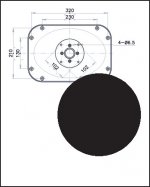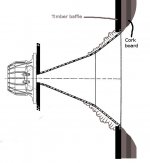I've listened to Bill Woods' conical horns and was impressed
They are very pretty. They tend to be used in large systems with megabuck drivers, so one would expect to be impressed
As far as I know, they are all used freestanding for time alignment, which means sharp edges / abrupt termination at the mouth. This means they cannot be used near their cutoff frequency, thus have to be huge, relative to the range they can cover well. The result is a tall speaker stack, with the drivers widely spaced.
http://www.stereotimes.com/com062510BTR.shtml
If you're not a triode purist, and can apply digital delay to handle time alignment, I think merging the horn into the baffle (as I did) is a better way to go. The smooth mouth termination means the horn doesn't have to be as big (it can be run closer to the cutoff frequency), so you can greatly reduce the driver-to-driver distance.
Well, all speaker systems have compromises and the JBL engineers probably found out that the 630Hz crossover frequency was a good compromise in that application. Personally I am trying to minimize the compromises and a 600Hz crossover frequency with the 2384 is not ideal. I really wish it was the solution so I could stop looking for the "perfect horn", but unfortunately not.
If you had compared your 2384 to for example the larger 2360/Seos 30 horns crossed over at about 600Hz I can almost assure you that you would agree that these horns have more "growl" in the 600-800 area. But again, no one of these two can be used all the way up.
Measure your 2384 horns 0-15-30-45-60-75-90 degrees and you will probably understand without trying other horns.
I have never tried the 2453H-SL but I am sure they are better than f.ex. the Radian drivers. Personally I use the 2450SL with Truextent Beryllium diaphragms. I also have a pair of TAD ET-703, but I hope that I don't need to use them if I can find the right horn to play all the way from 600 and up. The 2384 have constant directivity up to about 17KHz and really don't need any tweeter.
Certainly agree about every speaker design is a compromise
I have measured the 2384 waveguide on and off-axis to confirm the good DI spec for the JBL 4722 system:
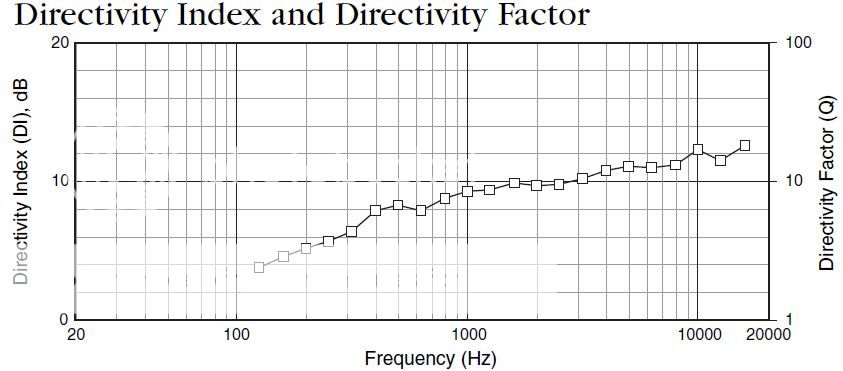
The DI increases from 400 Hz up and is pretty linear. It shows the 2384 seamlessly integrates with the bass section. There does not appear to be any measured DI issues or compromises using the 2384 to 630Hz. If there are polar or DI measurements that show otherwise, I would like to see them.
Re: Be diaphragms. User notnyt over at the AVSForum measured those and a bunch others and came to the following conclusion: Just purchased a pair of JBL 4722n speakers. - Page 136 - AVS Forum | Home Theater Discussions And Reviews I can't justify the extra cost for the Be. However, I am sure it sounds great on the 2384
That will be interesting. We are also working on a similar horn. It has a mouth width of 110 cm with constant horizontal directivity down to approximately 250 Hz. So a crossover around 500 Hz is not a problem as long as it works well for the driver.Now I am looking for a horn to use all the way from 600Hz and up. The 2384 is for now the best we have tried, but not large enough. Next step is a new horn constructed by a small team from Norway, soon a prototype is finished. Hopefully that will be the solution, if not the next step is to 3D scan the 2384 and upscale it big enough
We'll only release it if performs better than Klipsch K-410.
I don't have the 2384 horns here and only found this measurement with D2 driver right now - unfortunately only to 40 degrees off axis.Certainly agree about every speaker design is a compromise
I have measured the 2384 waveguide on and off-axis to confirm the good DI spec for the JBL 4722 system:

The DI increases from 400 Hz up and is pretty linear. It shows the 2384 seamlessly integrates with the bass section. There does not appear to be any measured DI issues or compromises using the 2384 to 630Hz. If there are polar or DI measurements that show otherwise, I would like to see them.
Re: Be diaphragms. User notnyt over at the AVSForum measured those and a bunch others and came to the following conclusion: Just purchased a pair of JBL 4722n speakers. - Page 136 - AVS Forum | Home Theater Discussions And Reviews I can't justify the extra cost for the Be. However, I am sure it sounds great on the 2384
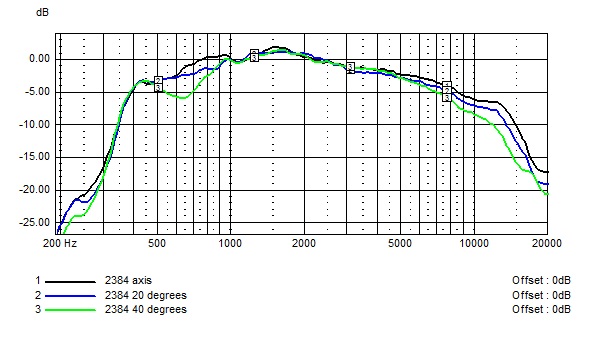
Aquapas diaphragms are good, but both measurements and listening impressions from several people with experience with both I have talked too and read about actually prefer the Beryllium diahragms over Aquapas. IMO they are pretty cheap too, I had a pair of blown TAD TD-4003 drivers earlier - the diaphragms list price is 2770 USD each!
That will be interesting. We are also working on a similar horn. It has a mouth width of 110 cm with constant horizontal directivity down to approximately 250 Hz. So a crossover around 500 Hz is not a problem as long as it works well for the driver.
We'll only release it if performs better than Klipsch K-410.
I have heard about those horns, 110cm is a little bit to wide for me and IMO not nescessary crossed over at 600Hz - but very interesting anyway! Is it a 2" or 1,5" exit horn? I am sure the K-410 is great, too bad it's 2" exit.
Last edited:
Yeah, it's really large. The JBL 2384 is a nice horn but a horn with CD lower in frequency which can be crossed lower really sounds better in several areas.I have heard about those horns, 110cm is a little bit to wide for me and IMO not nescessary crossed over at 600Hz - but very interesting anyway! Is it a 2" or 1,5" exit horn? I am sure the K-410 is great, too bad it's 2" exit.
The exit will be 1.4" and 1.5". I would never consider 2" exit. While 2" exit certainly works well in K-410 where beaming doesn't start before 10KHz, a smaller exit is an advantage.
Yeah, it's really large. The JBL 2384 is a nice horn but a horn with CD lower in frequency which can be crossed lower really sounds better in several areas.
The exit will be 1.4" and 1.5". I would never consider 2" exit. While 2" exit certainly works well in K-410 where beaming doesn't start before 10KHz, a smaller exit is an advantage.
I have couple of mid format horns that in many ways are better than the 2384 - I like the Keele EV HR6040 CE (conic exponential 33" wide) and the big HR9040 (CE 43" wide) and the Big Radial Horn BRH60 from Community Light and Sound. All these horns have no problem loading to under 500 and are usable down there with the right drivers. I also have the Sierra Brooks 180 Hz flare round tractrix horns that will tale 1.4 or 2" as well as other "big" 2" large format horns - The 60 degree horns sound excellent in my room. The 2384 is where I settled because my midbass horn sounds pristine all the out to 800-900 cycles and the 2384 sounds excellent above that (for a 90 degree horn) - What I'd like is a similar horn to the 2384 but 60 degree radiation and loading to 600. Two of the horns above will do that - Overall I like the 2384 for what it is but pushing it below 700 Hz is asking bit compared to the EV's or CLS radial. The big Klipsh horn you have has always intrigued me but have never heard a pair.
I'm mostly focused on getting my room tweaked in right now before I start swapping out horns again. lol
To me the OP is in a dilemma because he is using this AMT Beyma down to 2K - that IMO may be best served with a direct radiator midrange. He has built some cone driven midrange horns but doesn't seem to like the results??? Not clear.
Certainly agree about every speaker design is a compromise
Re: Be diaphragms. User notnyt over at the AVSForum measured those and a bunch others and came to the following conclusion: Just purchased a pair of JBL 4722n speakers. - Page 136 - AVS Forum | Home Theater Discussions And Reviews I can't justify the extra cost for the Be. However, I am sure it sounds great on the 2384
I have used the JBL 2435 HPL be driver in the 2384 and it is good - but the Altec 288 8G with throat sleeve is much better in this horn. I'm thinking the 4" diaphragm drivers with mid format 1.5 exit may be the way to go with this horn.Not sure though, all my mid format drivers use smaller diaphragms.
Last edited:
POOH:
Have you experienced the bi-radial EV horns to have any harshness?
The EV horns are not biradial - they are conic exponential hybrid horns.
The 9040 is bad in my room (my room needs fixed, i think i'm right about this) and the 6040 was a bit "hard" above 6K until I smoothed the throat. The throat from the factory is rather rough and can be greatly improved with a little work. I think the 6040 is really a gret sounding horn with the JBL 2435 or Altec 288's - The top actave I always use a small format driver because I don't like what I hear with mid formt up there. The "cleanest" mid format in my room (before I started fixing it) was the CLS Big Radial 60 degree horn. It is very realistic sounding midrange with JBL 2435 be driver. I'm curious to try in the "new room"
They are very pretty. They tend to be used in large systems with megabuck drivers, so one would expect to be impressed
As far as I know, they are all used freestanding for time alignment, which means sharp edges / abrupt termination at the mouth. This means they cannot be used near their cutoff frequency, thus have to be huge, relative to the range they can cover well. The result is a tall speaker stack, with the drivers widely spaced.
I listened to them sitting on top of a reflex cabinet. (The horns not me, I was on the couch.) The ones I really liked were a pair of Bill Woods' AH! 700 (not that big,. IIRC 13" across at the mouth) with B&C DCM50 drivers. Voice was wonderful, like someone speaking into your ear.
If you're not a triode purist, and can apply digital delay to handle time alignment, I think merging the horn into the baffle (as I did) is a better way to go. The smooth mouth termination means the horn doesn't have to be as big (it can be run closer to the cutoff frequency), so you can greatly reduce the driver-to-driver distance.
Nah, I'm impure enough, but the only digitally run system I've listened to more than briefly was done with a Deqx. I didn't like it. The friend who had it was an audio engineer who knew how to set it up and it was ok . . . . I guess . . . . . but I found it weird that his praise for the sound was that it never did anything wrong. I couldn't really disagree with his statement but it's like well behaved kids, there's a line that crossed turns one from nice to be around to making you feel they need some inspiration.
I don't have the 2384 horns here and only found this measurement with D2 driver right now - unfortunately only to 40 degrees off axis.

User notnyt has shown that the issue is with the D2430K driver going down that low, not the waveguide: Just purchased a pair of JBL 4722n speakers. - Page 128 - AVS Forum | Home Theater Discussions And Reviews
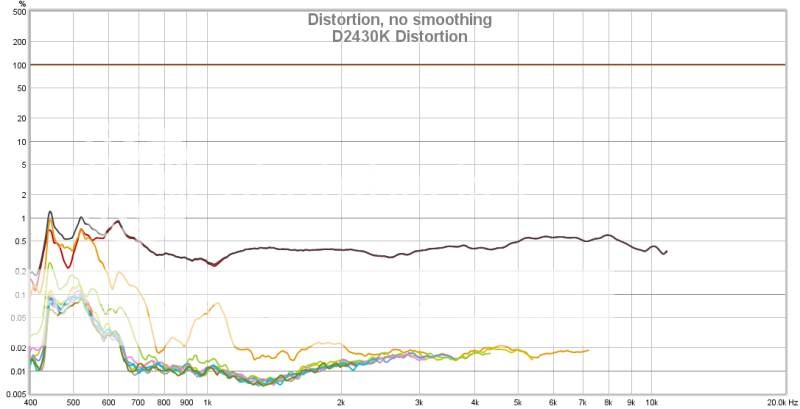
2453H-SL measured 10dB SPL hotter than above:
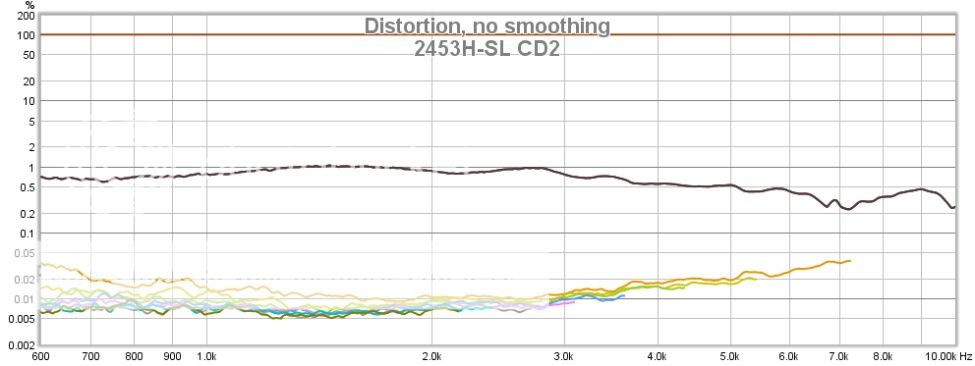
The THD/2HD is microphone distortion in both charts, but comparison on 2384 waveguide. The 2453H-SL 1.5" exit, 4" phragm can load down to 600Hz with very low distortion. Coupled with the good directivity index, 600Hz should not be an issue or compromise in anyway. At least it isn't to my ears at 630 Hz, with measurement support.
Good luck on your journey.
I listened to them sitting on top of a reflex cabinet. (The horns not me, I was on the couch.) The ones I really liked were a pair of Bill Woods' AH! 700 (not that big,. IIRC 13" across at the mouth) with B&C DCM50 drivers. Voice was wonderful, like someone speaking into your ear.
Thanks for the info. That driver with it's old school paper diaphragm seems interesting; I like the idea of going to 10kHz well, and then stopping.
I tried these other 2" B&C drivers once (~same thing, but titanium) and they weren't "wonderful". They seemed impressively detailed, but long-term, were a bit too steely / fatiguing, on this pictured horn. I presume that's cos they were only flat to 6kHz, with very typical titanium breakup extending the response to 18kHz.
c-to-c spacing
In the setup you describe, the closest c-to-c spacing possible (with a 12" woofer mounted right at the top of the bass cabinet) would be about 400mm (16") since the AH700 has a 17" flange. For a 1,000Hz crossover, that's 1.2 wavelengths apart.
For comparison, a Faital LTH142 (not a conical - but has a 50x60 coverage angle, so has some similarity to the 60 degree AH700) can mount closer and cross lower. With a 12" woofer, it would be 0.6 wavelengths apart for a 800Hz crossover.
Do you recall if that large spacing actually mattered? Did the AH700 system lobe / sound best at one height (that is: was there a big difference in quality when you stood up)?
I didn't like it [Deqx] I found it weird that his praise for the sound was that it never did anything wrong.
Different strokes / can't dispute personal preferences. For me, doing no wrong seems like a great result.
Do you recall if that large spacing actually mattered? Did the AH700 system lobe / sound best at one height (that is: was there a big difference in quality when you stood up)?
Well, it was a few years ago but what I remember was that it sounded good coming into the room in a way that made me want to sit down and listen more carefully. I don't recall more than that, other than the comment I made about vocals.
Different strokes / can't dispute personal preferences. For me, doing no wrong seems like a great result.
I understand, but doing no wrong is better when coupled with doing something right. I don't have trouble with a system that occasionally barks or bites especially if it's from the recording and not the speaker's fault. To me it's forgivable if better than 99.99% of the time the music is wonderful. The setup with the Deqx ironed out all the wrinkles but also the life.
As for the DCM50. The price fell from $600 to $350 so I'm guessing it's not a big seller. I did some poking around last night looking for user comments on it but didn't find much. One fellow over at good sound club talking about the ones he had converted to field coil - which he uses with 300Hz conicals, and I think there was one on the Asylum. Pretty sparse.
For you, if you want the best option from 450-2000Hz - stop looking and buy the Seos 24-4+CMCD-81H. A friend use the same driver/phase plug in a custom Tractrix 180 Wood horn because he rather wants the round horn profiles of esthetic reasons. Works really well that too!
Thanks all for the insightful comments.
Maybe POOH is right and my use of the TPL above messes usi a midrange CD. Seems I should be using a CD from about 800Hz and up.
Maybe the Seos 24-4 plus a cone is a good idea. Maybe instead of buying a CMCD now I try with my 5" Faital M5n12, though, of which POOH thought highly vs CMCD. Maybe I can get to 500/550Hz XO? Jorge, what do you think?
And maybe I can get my wife not to kick me out with such large horns in the living room? 😀
LTH-142 loaded with a very nice 1.4 could serve well as an upper mid, especially if the 10, or 12 inch below, was relieved of it's very deep bass duties !
Yea.
Knock-offs of the horn are available for $30, so cheap experiments ahoy.
(444) 9" x 14"Oval 1.5" or 1 1/2" Bolt-On Horn For Many 1.5" or 1.4" Exit Driver | eBay
To make a beefy satellite speaker with these, I think I'd:
1) cut an inset, and screw the horn flush to the baffle (with only 7 screws)
2) plaster a litre of liquid nails (or similar) over the rear of the horn, to thicken it and to guarantee an airtight seal with the baffle.
3) Use a router to cut the woofer mounting hole right through the last of the LTH-142 screw holes, as pictured.
The layout would be like a big bookshelf speaker, with c-to-c spacing a lot closer than a 'normal' stacked system (separate horn placed on top of the bass box).
Response of the 142 looks best >1kHz but could be taken as low as 700Hz, as this chap did (with DSP).
HF144 with FaitalPro LTH142 and Pyle PH916 – outdoors directivity measurements | MiniRIG
Attachments
A cone driver on a horn that big should have no trouble going to 500Hz. The SEOS horns look good. Expect >100dB / watt; slightly less than a CD, but easily enough to match the TPL.Maybe the Seos 24-4 plus a cone is a good idea [...] my 5" Faital M5n12 [...] Maybe I can get to 500/550Hz XO?
Negatives of the SEOS 24 (in this application): only 195mm deep, small throat, shipping it from Europe.
If you can get a longer horn, you can go lower. A 2" throat will give a less extreme compression ratio; lower distortion.
11" x 17" ABS 2" Bolt-On Long Throw Horn 90° x 40° For Many 2" Exit Driver | eBay
I got a pair of these and extended the mouth with a lot of effort (grinding + timber + filler). The result has the mouth size of the SEOS 24, but is about 15cm deeper.
In hindsight, my method was dumb: a lot more work than is needed. If I did it again, I'd just mount the cheap horns onto a baffle, then laminate on a few layers of something soft and easy to cut. A few sheets of cork tile would do the job.
Attachments
Well, the JBL engineers have put a lot of work into the CMCD concept. I doubt that you will find any better driver for this use, remember that the 2169H driver is constructed for this use! Crossed over at about 2000Hz you will also need a phase plug and closed rear chamber to get enough compression with other drivers. So if you are going to use any other drivers you have some construction work to do. Why try to reinvent the wheel?Thanks all for the insightful comments.
Maybe POOH is right and my use of the TPL above messes usi a midrange CD. Seems I should be using a CD from about 800Hz and up.
Maybe the Seos 24-4 plus a cone is a good idea. Maybe instead of buying a CMCD now I try with my 5" Faital M5n12, though, of which POOH thought highly vs CMCD. Maybe I can get to 500/550Hz XO? Jorge, what do you think?
And maybe I can get my wife not to kick me out with such large horns in the living room? 😀
I don't know the Faital driver but the Seos 24-4 horn itself loads twice as low as your target... How are you thinking about mounting the 5" Faital driver to the 4" exit on the CMCD horn?
The sensitivity of the CMCD in the Seos 24-4 is 106db after you have used EQ to flatten the response. Perfect match to my TAD TD-2001 in Seos 12 after EQ to play flat to 20k.
The measurements I posted for the little Faital driver on your other thread showed the driver should work fine in that range but may require a creative low pass, so would the CMCD. The 4" throat is fine with SEOS , the 5.25" driver has a 4" cone. I would recommend a smaller throat for wider bandwith though. The little seos 24 with faital 5.25 driver may have a problem on the bottom but no worse than any compression driver. I can't imagine the seos 24/4 being very long
Last edited:
- Status
- This old topic is closed. If you want to reopen this topic, contact a moderator using the "Report Post" button.
- Home
- Loudspeakers
- Multi-Way
- Which horn from 450 to 2000Hz? K-510?
